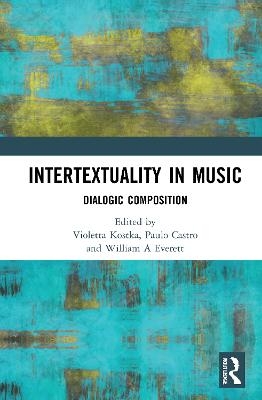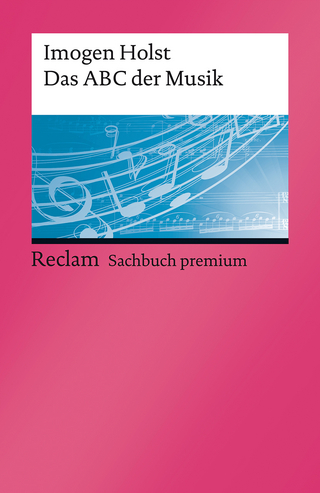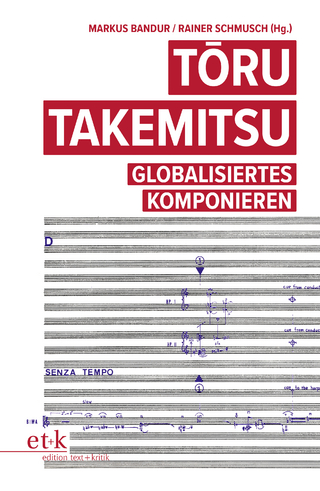
Intertextuality in Music
Routledge (Verlag)
978-0-367-55290-9 (ISBN)
The concept of intertextuality – namely, the meaning generated by interrelations between different texts – was coined in the 1960s among literary theorists and has been widely applied since then to many other disciplines, including music. Intertextuality in Music: Dialogic Composition provides a systematic investigation of musical intertextuality not only as a general principle of musical creativity but also as a diverse set of devices and techniques that have been consciously developed and applied by many composers in the pursuit of various artistic and aesthetic goals. Intertextual techniques, as this collection reveals, have borne a wide range of results, such as parody, paraphrase, collage and dialogues with and between the past and present. In the age of sampling and remix culture, the very notion of intertextuality seems to have gained increased momentum and visibility, even though the principle of creating new music on the basis of pre-existing music has a long history both inside and outside the Western tradition. The book provides a general survey of musical intertextuality, with a special focus on music from the second half of the twentieth century, but also including examples ranging from the nineteenth century to the second decade of the twenty-first century. The volume is intended to inspire and stimulate new work in intertextual studies in music.
Violetta Kostka trained as a musicologist at the University of Poznań and received her PhD and habilitation from the Institute of Art of the Polish Academy of Sciences in Warsaw. Paulo F. de Castro, PhD, University of London (Royal Holloway), is Associate Professor and Head of the Musicology Department at Universidade Nova, Lisbon. William A. Everett, PhD, is Curators’ Distinguished Professor of Musicology at the University of Missouri-Kansas City Conservatory.
Introduction: Violetta Kostka, Paulo F. de Castro and William A. Everett
Part I. Musical Intertextuality: Defining the Field
Lawrence Kramer, What Is (Is There?) Musical Intertextuality
Nicholas Cook, Mashed-up Classics
Michael L. Klein, Intertextuality and a New Subjectivity
J. Peter Burkholder, Making Old Music New: Performance, Arranging, Borrowing, Schemas, Topics, Intertextuality
Part II. The Intertextual Poetics of Music
Violetta Kostka, Intertextual Poetics: From Ryszard Nycz’s Theory to Paweł Szymański’s Music
Katarzyna Szymańska-Stułka, Barbara Skarga's ‘Trace and Presence’ as an Intertextual Category in Music: The Case of Dariusz Przybylski’s ‘Schübler Choräle’ for Organ, Op. 48
Alexander Kolassa, Intertextuality and (Modernist) Medievalism in British Post-War Music
Part III. In Light of Genette’s Transtextuality
Paulo F. de Castro, Transtextuality according to Gérard Genette ─ and beyond
William A. Everett, ‘The Geisha’ (1896) as a Locus of Transtextuality in Popular Musical Theatre
Nils Grosch, Musical Comedy, Pastiche and the Challenge of ‘Rewriting’
Part IV. Constructing Meaning through Intertextual Music
Tijana Popović Mladjenović and Leon Stefanija, The Musical Text as a Polyphonic Trace of Otherness
Mark Hutchinson, ‘Strange and dead the ghosts appear’: Mythic Absence in Hölderlin, Adorno and Kurtág
Francesca Placanica, Constructing ‘Cathy’: Intertextuality and Intersubjectivity in Luciano Berio’s ‘Recital I (for Cathy)’
Edward Venn, Findings, Keepings and Borrowings: Uncanny Intertextuality in Thomas Adès’s ‘Powder Her Face’
| Erscheinungsdatum | 18.06.2021 |
|---|---|
| Zusatzinfo | 3 Tables, black and white; 12 Halftones, black and white; 12 Illustrations, black and white |
| Verlagsort | London |
| Sprache | englisch |
| Maße | 156 x 234 mm |
| Gewicht | 453 g |
| Themenwelt | Kunst / Musik / Theater ► Musik ► Musiktheorie / Musiklehre |
| Geisteswissenschaften ► Sprach- / Literaturwissenschaft ► Anglistik / Amerikanistik | |
| Geisteswissenschaften ► Sprach- / Literaturwissenschaft ► Literaturwissenschaft | |
| Sozialwissenschaften | |
| ISBN-10 | 0-367-55290-6 / 0367552906 |
| ISBN-13 | 978-0-367-55290-9 / 9780367552909 |
| Zustand | Neuware |
| Informationen gemäß Produktsicherheitsverordnung (GPSR) | |
| Haben Sie eine Frage zum Produkt? |
aus dem Bereich


